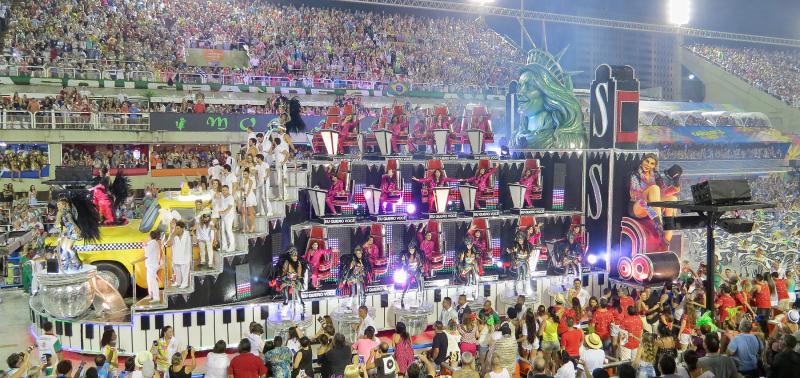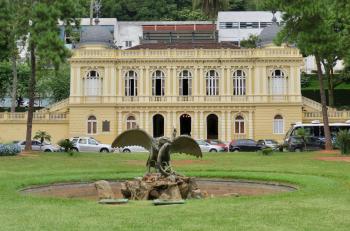Caught up in Rio’s spectacular Carnival
This article appears on page 34 of the November 2017 issue.
My husband, Charles, and I took a 23-day Amazon cruise — down the eastern coast of South America and up the Amazon River — that ended in Rio de Janeiro, Brazil, on Feb. 25, 2017. However, we were unable to get a flight out of Rio until Feb. 27.
When we realized that Rio’s Carnival would be in full swing at that time, we decided to hire a guide from Tours By Locals (Vancouver, BC, Canada; 866/844-6783, www.toursbylocals.com) for the two days ($665 total).
Seeing some sights
Traffic in the city was terrible due to all the Carnival activities, but we were able to see all the usual sights in and around Rio — the Metropolitan Cathedral of Saint Sebastian; the Selarón Steps; the Botanical Gardens; the “Christ the Redeemer” statue; Sugarloaf Mountain, and the various beaches.
We stayed at the Arena Leme Hotel (Av. Atlantica 324; www.arenalemehotel.com.br) for $800 for the two nights. It had a good location right in front of Copacabana Beach and just a little distance from the main activities.
Charles has a business connection in Rio, so we contacted him to see if he could help us get tickets to the samba competition that would take place in the Sambadrome on Sunday, Feb. 26. He was the perfect host, arranging a car and driver for us on Sunday so that we could see some of the Brazilian countryside.
Our host gave us a tour of his town, Petrópolis, about 25 miles north of Rio. Petrópolis is quite a historic gem and was a pleasant surprise.
Also known as The Imperial City, it was named for Pedro I and Pedro II, the only emperors of Brazil. Pedro I loved the scenery and climate, so he bought land there. When he went back to Portugal, he passed the land on to his son, Pedro II, who built a summer retreat.
Soon a palace, cathedral and many mansions were built, and Petrópolis became the state capital (from 1894 to 1902).
Due to time constraints, we only were able to walk around the grounds of the Imperial Museum and the Cathedral of Saint Peter of Alcantara, but there are so many other places of interest there. It is well worth at least a day’s visit if you are in Rio, and you could certainly spend two or three days there.
Samba!
Then we headed back to Rio and its Carnival, something that has to be experienced to be believed!
The highlight of Carnival is the competitive parade that takes place in the Sambadrome, a half-mile-long parade area designed by Oscar Niemeyer and built in 1984 specifically for Rio’s Carnival, a pre-Lenten festival that dates back to 1723.
The contemporary festivals are thought to have developed in the favelas, or slum neighborhoods that originated in Brazil in the late 19th century. Samba schools were developed by the working-class families who lived in the favelas, and that is where most of the activity still resides today.
In preparing for each year’s parade, each community that has a samba school has an individual or individuals who design and organize the fantastic costumes, tremendous floats, songs and dance routines according to that year’s theme. All of this involves months of preparation, which starts as soon as the previous year’s competition ends.
The samba schools are a huge source of pride for their communities, and a special bond is created among community members.
In a facility called Samba City, where money-raising events are held to support the tremendous cost of the annual event, there is space for each school to build floats, create costumes and practice dance routines. There are also private sponsors and government support for the samba schools. The schools provide valuable employment for thousands of people from these poor neighborhoods.
The schools take their responsibility toward the community seriously, with each one supporting a cause. Youth receive guidance from community elders, and programs are developed to encourage Rio’s less fortunate to stay away from criminal activity. Education and rehabilitation are among the primary responsibilities undertaken by the schools.
The main event
While there are many schools, only the top 12 participate in the Sambadrome parade. Other schools’ floats take part in parades along the streets in Rio.
We attended the parade on Sunday, Feb. 26, to see six samba schools compete. We were provided transportation from our hotel to the Sambadrome, where we were seated in Section 5, a covered area about two levels above the main runway/parade level.
We arrived about 8:30 p.m. to await the start of the first parade at 10. Included with our tickets in this section were hors d’oeuvres, champagne, wine, liquor, soft drinks and, later, a buffet dinner. There also were a samba band and a dance group that entertained us while we waited for each samba school parade to begin.
I am not sure what the tickets cost, since they were part of some business dealings, but we think tickets in the viewing area where we were seated cost about $1,000 each. Tickets start at around $90 each, depending on the section chosen.
Each samba school had about 4,000 members and 10 enormous floats, with groups of 100 or so samba dancers between the floats. The dancers wore fantastic costumes and were dancing and singing continually, from the beginning to the end of the procession.
Fireworks marked the beginning of each school’s procession, and it took about an hour and a half for each procession to get to the other end of the Sambadrome. Then it was another 30 minutes to clear the route to prepare for the next samba school.
During the competition, judges were located in various areas around the runway. At the end of the second night’s competition, the judges’ scores are tabulated and the winner is announced. The 2017 winner was the Portela samba school, whose theme was an allegorical story about the importance of water and its relationship to human life. That school performed the following night, so we did not see them.
We ended the night — or, rather, morning — at 5 a.m. There still was one more samba school to go, but we were completely worn out by that time. The parade had been late in starting, and later we found out why.
At the very beginning of the parade, the first samba school’s float had veered off course and swerved into the crowd along the inside of the fence. Several people were injured, but after they were treated or sent to the hospital, the parade resumed. We had no idea at the time that anything had happened.
We do not know Portuguese, so we really didn’t know what the theme of each school was or what the songs were about, but it still was one of the most amazing things we have ever seen. It was something we never would have considered attending had it not fallen into our laps, but I’m sure glad it did.




